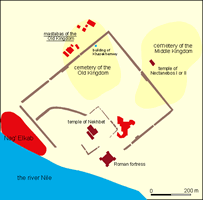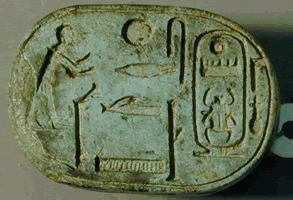 |
 |
 |
|
architecture |
written record and depictions
|
weapons
|
Types of evidence for warfare in ancient Egypt in the archaeological record (in general see Shaw 1991)
Architectural features on sites provide some of the best evidence for conflict in ancient times (examples: the Middle Kingdom fortresses in Buhen, now under Lake Nasser; squared towers on casemate foundations at Defenna and Naukratis).
Sometimes features are ambiguous: Petrie interpreted high mounds in Delta sites as 'Hyksos forts' but some may be temple platforms, and their dates are disputed (examples: Iunu/Heliopolis, and Tell el-Yahudiya)
Some of the best attested ancient wars are known mainly or even only from written sources: the inscriptions and dramatic cycle of depictions on the walls of the main temple to king Ramses III are the only sources for battles between the Egyptians and northern peoples 'amid their islands' or 'of the sea' - the 'Sea Peoples' of modern historiography: their identity and importance are still debated (see Kuhrt 1995 for the view that they are peoples between the Mycenaean and Hittite realms, benefiting from the disintegration of Hittite power in the 12th century BC).
Alone, without archaeological or architectural corroboration, written and pictorial sources for ancient conflict may be difficult to interpret. Modern commentators are liable to misrepresent ancient written and pictorial content, if they pay insufficient attention to its context in ideology, architectural setting, and the development of the particular genre in time. One of the clearest instances of misrepresentation concerns the Battle of Qadesh between king Ramses II and the Hittites: modern commentators tend to see the Egyptian version as empty propaganda in the face of defeat. However, in ideological context, the Egyptian account of the battle is intended not as journalistic reportage, but as a hymn of praise to the divine king, whom the gods favour by extracting him from almost certain defeat. In the history of such expressions in the cult of the king, the images form a climax in the development of pictorial narrative, unparalleled in Egyptian art history, and the written accompaniment also forms a peak in a genre of 'praise of the king' (known in Egyptology rather awkwardly as 'the king's novel'), where the divinity of the king emerges against the flat background of human action in history (for the genre see Loprieno 1996).
References
Copyright © 2003 University College London. All rights reserved.